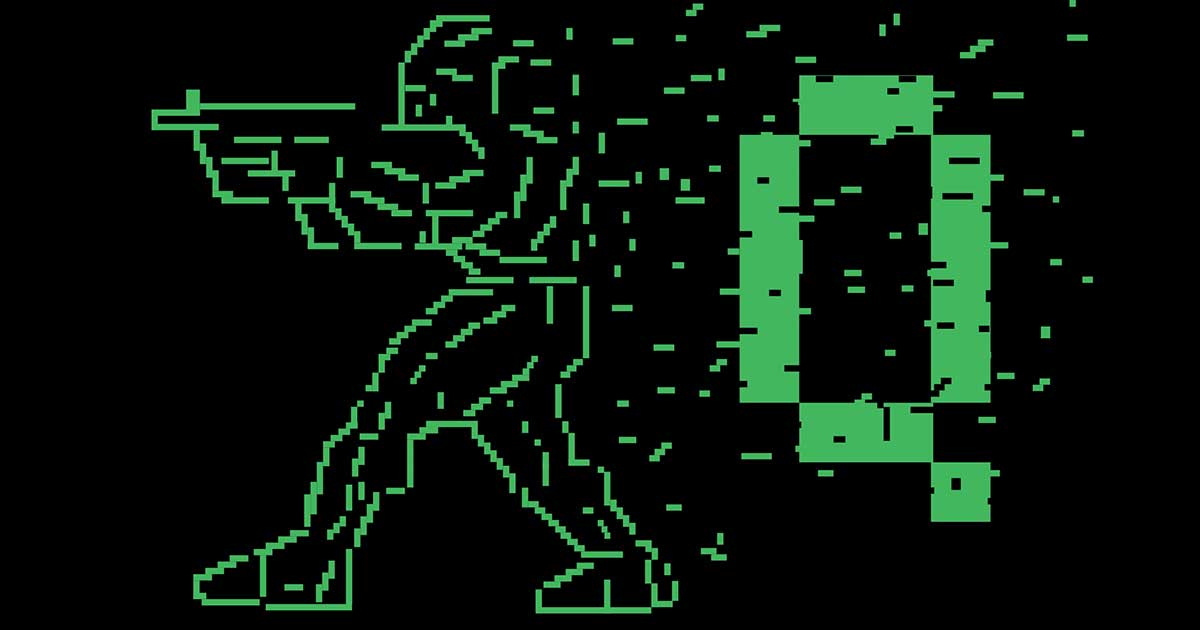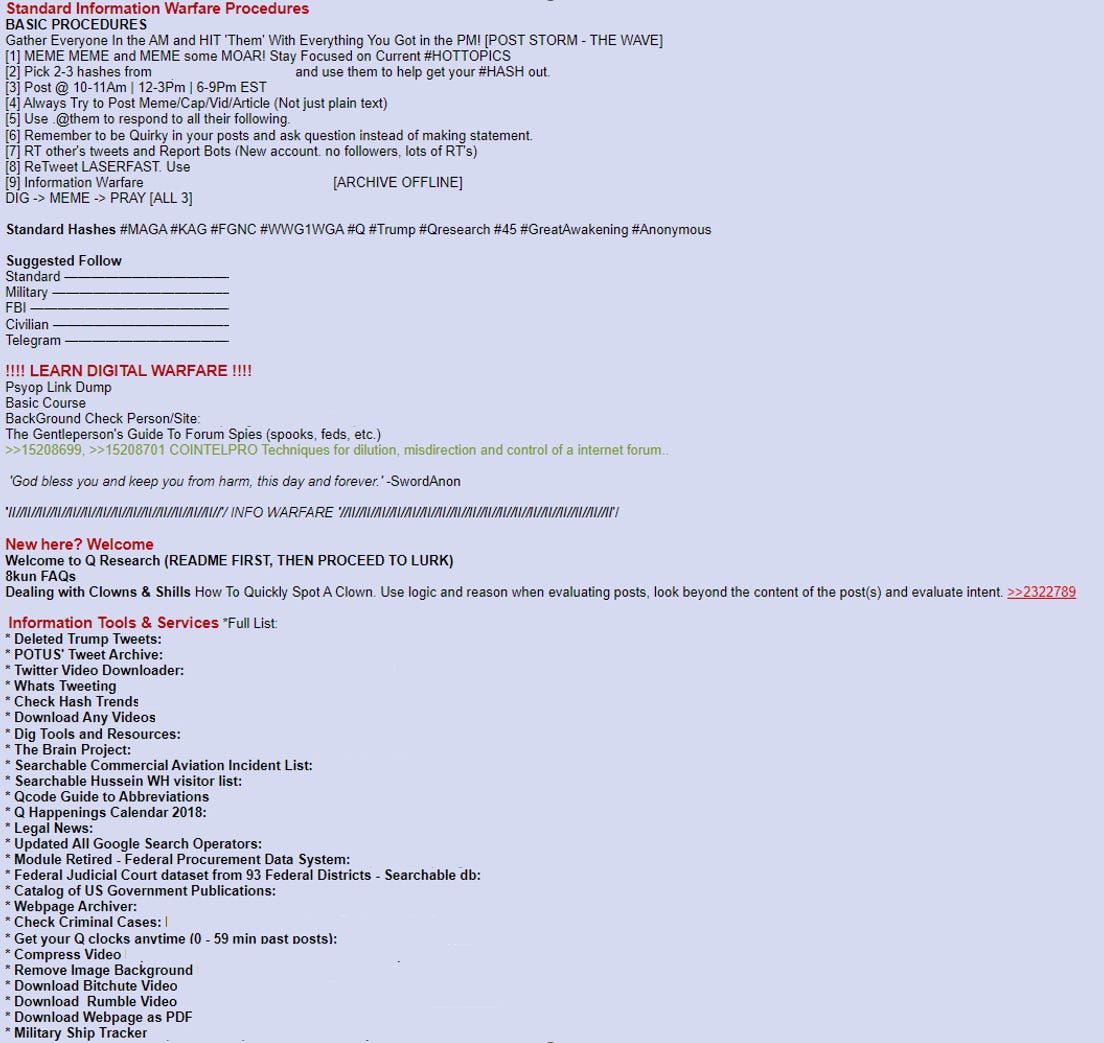How Do You Join QAnon?
Being a member of the QAnon community is about praxis. An individual must participate in the conspiracy theory and community to become a member.
Today is the anniversary of the January 6, 2021 insurrection. To that end, I wanted to share some insight from my PhD dissertation and answer a question I have received numerous times: how do you join QAnon? The simple, yet complex, answer is: you don’t. QAnon is not a movement that is hierarchically structured, rather the influence or direction of activity of QAnon is ambiguous. There was the poster(s) known as “Q” over the years playing the role of Oracle, and you have influencers on the movement that can impact ideology and interpretation, but there is no vetting process, there are no initiation rituals or interviews. The way you join QAnon is through praxis (from the Greek πρᾶξις word to do), which means that you become a member of the QAnon community by participating in the community and the conspiracy theory narratives and activities associated to them.
QAnon as a new religious movement.
In December 2022, I had a book chapter published, which expands on this May 2020 article, which argues that the QAnon movement has evolved beyond a simple conspiracy theory into a new religious movement (NRM). In this chapter, I argue that QAnon should be seen seen as a “hyper-real religion” (a term coined by sociologist Adam Possamai), which is defined as “a simulacrum of a religion created out of, or in symbiosis with, commodified popular culture which provides inspiration at a metaphorical level and/or is a source of beliefs for everyday life.” Simply put, a hyper-real religion is based on the premise that pop culture shapes and creates our actual reality, with examples including, but not limited to: Matrixism, Church of All Worlds, Jediism, etc. As a movement in a constant state of mutation, QAnon clearly blurs the boundaries between popular culture and everyday life. Applying the notion of hyper-real religion helps in providing a framework to understand why its members incorporated QAnon into their worldview and their online/offline behaviors. What this means is that technology and the marketplace of ideas have inverted the traditional relationship between the purveyors of religion and the consumers of religion. Thus, in my analysis of QAnon I have observed religious doctrinal authority (that is, those who can contribute to the new religious movements teaching) being created by popular culture.
Not only do I argue that QAnon is a NRM in my research, but that it is a lived religion whereby QAnon as an ideology should be understood via what adherents are doing or practicing in a distinctive sense. Therefore, QAnon as practice, means examining and understanding “the patterned regularities in what people do, and we seek to understand those patterns in the context of the cognitive models and the overlapping social fields of interaction that make them meaningful and allow us to act.” (Ammerman 2021)
Studying the QAnon community as a “lived religion” means watching how its members act religiously, even if their actions seem random and don't fit well with other things they do or if they aren't really believers in the strict sense of the word. As part of my research, I had to think about how people who believe in QAnon get their religious identities. When I did this, I focused on how QAnon followers act in ways that show they are part of the group and how their political beliefs and actions are influenced by QAnon. Ammerman says that “lived religion approaches allow us to take seriously both everyday understandings of social action and official categorizations of that action.” (Ammerman 2021)
What are QAnon practices?
When studying the QAnon movement, it's important to know that “Q” and other QAnon influencers used emotionally charged actions and stories to elicit an emotional response in their followers. This made people feel more invested in the QAnon milieus, as it rewarded those who “did their own research,” as the QAnon saying goes.
In QAnon, people show that they are part of the movement by taking part in the digital war. As there are no formal ways to join the QAnon movement, the only way to identify as a follower and be accepted is to answer the call from “Q” and become a digital soldier to help Trump and “Q” fight against the Deep State. Since the beginning, one of the most important ideas in QAnon has been that “Q,” military intelligence, and Donald Trump are at war with the Deep State. “Q” was a key player in the information war against the Deep state, which Trump and the military were going to handle. The idea behind Qdrops is that the Deep State is watching everything and knows about “Q” and Trump, so the only way for information to get out was through cryptic messages from "Q" on 4Chan/8Chan/8Kun. “Q” also pushed for the spread and amplification of memes and false information, since that was the digital ammunition that was needed to defeat the Deep State-controlled MSM.

QAnon adherent behaviou’s on the chans are very ritualized, in example, baking bread (a term for the anonymous users who put together threads on the QResearch chan boards or on social media so they can be decoded) is a ritualized practice which leads to decoding the new or old Qdrops. In turn this leads to the creation of what adherents call “digital ammo”. “Q” and QAnon influencers have called followers who shared decoded intelligence from Qdrops on mainstream platforms “digital soldiers.” On the QResearch boards, there were links that lead to instructions on How to Red Pill, when is the best time to post, how to make memes, and MEGA links to images that could be used for memes. Making memes and A/B testing them was also encouraged on the QResearch boards. The memes on QResearch and QAnon, as well as the "findings" from the bread, were to be used as “digital ammunition” against the Deep State and the media, and they made up most of the harmful and violent content that QAnon spread.

But QAnon followers don't see it that way. They think that, like the apostles of old, they are spreading the good news and telling the truth that everyone needs to hear in order to save the world. QAnon adherents perceive they are participating in a wider salvific mission to save the world.
QAnon practices have evolved with the movement itself
It is a QAnon adherent’s practices as a digital soldier that signals their identification with the QAnon tradition and how it dictates their life. Though QAnon may appear to outsiders and wacky and irrational, examining it as a lived religion requires us to take seriously the belief as their practices, as weird as they may be, direct their experience of sacredness. We cannot judge QAnon as a religion based on whether it is acceptable, or marginal or illegitimate. QAnon as a lived religious practices orients an adherent toward things that we can recognize as religious, that is because “religion” is a socially defined category, and that means that context matters.
Within a similar religious tradition practice varies, this remains true for QAnon. In my analysis of QAnon, their live religious practices changed overtime depending on the ecological and socio-cultural shifts. Lived religious practices can occur in any aspect of daily life in any culture, whether or not they are recognized as such and given institutional status. It's important to keep in mind that lived religion might explain behavior’s that adherents themselves classify as religious, whether or not our own culture would agree.
Furthermore, lived religion can be used to explain behavior’s that are characterized as religious even though people do not directly and personally experience something transcendent as a result of them due to their affiliation with culturally accepted religious institutions, identities, and organizations. In other words, religions frequently adopt a social reality that transcends personal experience and influences the behavior’s of individuals who interact within it. What I found is that there are variations in praxis within QAnon that exist depending on the time period in which one believed and participated in QAnon, the platforms being used and the ecosystem they are active in. Praxis is mediated via technological use, especially during the pandemic when many of us were locked in for long periods of time, and offline praxis was not possible.
The practise of lived religion is a way of recognising that religious actors behave in predictable ways. Practice is not aimless or random, but rather takes on a structure or shape that we commonly refer to as "ritual." What is important for QAnon is what happens inside the spaces that have been officially designated as approved sites for "religious" practise: i.e. qresearch board on 8chan/kun where all the decodes and baking took place, the digital ecosystems influencers control, Trump rallies, protests against government official and law enforcement, etc. What's also important is how QAnon adherents ritualise and practice their belief outside of canonical QAnon spaces like Pastel QAnon, -48, Romana Didulo, Gematria or other QAnon adjacent spaces. The rituals that take place outside or on the outskirts of QAnon space are important. Lived religion is about the framework of meaning that is embedded within any given practice. Meaning making is key to QAnon belief as the conspiracy theories that make up QAnon act to explain what is happening in the world and offer an easy answer as to why they occur. Therefore joining QAnon via practice highlights how this is both a communal and individual process, whereby the praxis of QAnon is particular, local, variable, and otherwise shaped by specific cultural, social, political, material, and other contexts of human experience rather than as a sui generis universal phenomenon. This last point is extremely important when exploring QAnon outside the US and examining QAnon post “Q”. Especially as groupuscules centered around one or many influencers have become the new norm of QAnon ritual and religious practices.